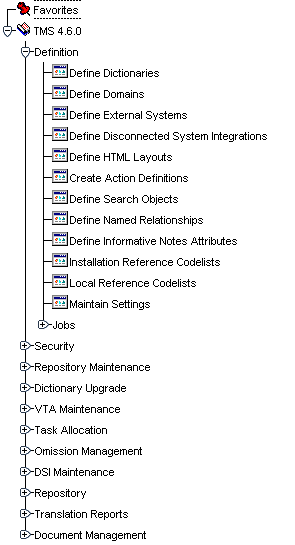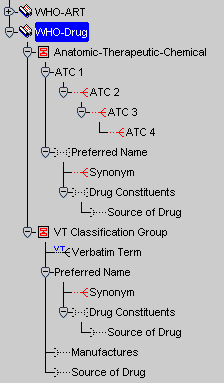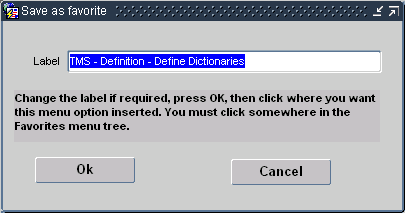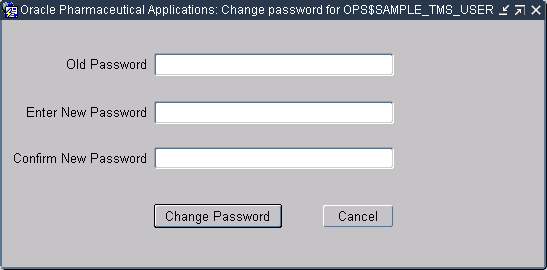Basics of Using TMS
The following sections describe the interface and cover common features in TMS, including:
- Launching the Application
- Getting Started with Your Oracle Health Sciences SSO Account
- Changing Your Database Password
- Using TMS Windows
Parent topic: Getting Started
Launching the Application
TMS runs in a Java-based window that you initiate from the launch page. To start a session:
Note:
Do not open another Thesaurus Management System session from this session. To start another Thesaurus Management System session, open it from the Windows Start menu or from the Internet Explorer desktop icon. If you instead start a new session by selecting New from the File menu or by using the shortcut combination Ctrl+N, the new session may be unstable and unpredictable.
Parent topic: Basics of Using TMS
Getting Started with Your Oracle Health Sciences SSO Account
Your organization will create an Oracle Health Sciences SSO account for you. With this account, you can access any Oracle Health Sciences SSO-enabled application owned by your company and to which you are authorized, including TMS.
After your account is created, you receive three email messages, which contain:
-
Your account name, which you can use to log in to Oracle Identity Self Service and other Oracle Health Sciences SSO-enabled applications.
-
A temporary password for your account and a link to Oracle Identity Self Service where you can manage your account.
-
Your DB Login Name for the account, which you can use together with the Oracle Health Sciences SSO account password to log in to TMS.
Save the link to Oracle Identity Self Service so that you can access it whenever you need to manage your account settings. Do not save it in your browser by bookmarking the address where the link redirects, but by right-clicking on the link in the email message and choosing to copy the underlying link address.
Initial Setup
After you receive the messages containing your account name and temporary password, click the link to Oracle Identity Self Service to set up your account.
When you log in to your Oracle Health Sciences SSO account for the first time, you must reset your account password and define challenge questions for your account. Challenge questions are security questions that you must answer to verify your identity when you use the Reset Password link from the Oracle Health Sciences SSO login page.
Assistance with Your Account
Your organization's delegated administrator manages user accounts for all your company's Oracle Health Sciences applications that are SSO-enabled, including TMS. Contact your organization's delegated administrator for assistance related to your Oracle Health Sciences SSO account if:
-
Your account is locked because you entered the wrong password too many times.
-
You need help resetting your account password.
-
You need help updating account information, such as first or last name, email address, or user name.
-
You require additional privileges or encounter access issues.
Parent topic: Basics of Using TMS
Changing Your Database Password
This section describes how to change your own password in the TMS database. You can only change your password for the database to which you are connected; you must repeat these steps for every database in which you want to update your password.
There are three methods of changing your password, depending on your privileges and on whether Oracle Clinical is integrated with TMS:
If You Have Administrator Privileges in This Database
If you have privileges equivalent to the SYSTEM user in this database, you can change your own password (and update the passwords of other users in the database) from a SQL*Plus prompt. This process is an administrator-level activity, so see Changing a User's Password.
If Oracle Clinical Is Not Installed in This Database
If you are running TMS in a standalone configuration, follow the procedure in this section to update your database password.
If Your Database is Integrated With Oracle Clinical
If you are connected to a database that is integrated with Oracle Clinical, you can change your own password either by selecting Options, then Change DB Password from the Navigator window or from the Change Database Password window in Oracle Clinical (From Oracle Clinical's Admin menu, select Users, then Database Password). However, once you launch the Change Database Password window, the system deactivates the Change DB Password selection under the File menu for the rest of your session.
Note:
When you use the Oracle Clinical Change Database Password window to change your password in an integrated database, the system disables TMS windows for the rest of your session. You must exit and reenter TMS before you can open any windows.
Parent topic: Basics of Using TMS
Using TMS Windows
All TMS windows, except those used for creating reports and other batch jobs, provide the same set of icons, keystrokes, and menu options to perform common functions. Windows used for reports and batch jobs provide another set. GUI Quick Reference contains a complete set of icons, keystrokes, and menu options for functions in both types of windows.
This section contains additional information on the following tasks in the GUI.
- Understanding Color Indicators
- Changing the Display
- Using the Tree Structure
- Changing the Sort Order
- Options Menu
- Showing the Environment
- Selecting Multiple Records
- Changing the Database Connection
- Printing the Contents of a TMS Window
- Querying in Windows
- Using the Favorites Menu
Parent topic: Basics of Using TMS
Understanding Color Indicators
TMS conveys some information using color cues.
Table 1-2 Color Indicators in the User Interface
| Function | Color Displayed | What is Colored |
|---|---|---|
|
Current record |
Blue |
Area to left of record |
|
Query mode |
Light blue |
Field background |
|
Mandatory field (batch jobs and reports) |
Red |
Text in field |
|
Drill-down information available |
Blue |
Text in field |
|
Read-only information |
Gray |
Field background |
Parent topic: Using TMS Windows
Changing the Display
You can change the way data is displayed by selecting single- or multi-record display. You can change which data is displayed by using the tree structure and querying. See Using the Tree Structure and Querying in Windows.
Single/Multi-record Display Option
In general, the single-record display is more useful when you are modifying data because it allows you to see all the information for a record at once, without scrolling. The multi-record display is useful when you are querying; you can scroll up and down to quickly see all the records retrieved, and scroll across to see the complete information for each record.
Sort Order
You can sort records on any active column label (column labels that appear three-dimensional, with the column heading in boldface). Click once to sort on a column in ascending order. Click again to sort in descending order. Click a third time to return to the default unsorted state. A sort icon appears in the label after you use it to sort. The system sorts numbers by the first digits, no matter how many digits the number contains, so that 12345 comes before 543 in ascending order.
Parent topic: Using TMS Windows
Using the Tree Structure
The tree structure that appears on the left of many windows serves different purposes depending on the window, but its behavior is consistent throughout TMS:
- Nodes, or branches, of the tree structure expand and collapse when you click the boxed + or - icons in the tree structure, use the +, -, ++, or -- icons in the toolbar, or use the menu options in the Navigation menu.
- The system populates the right side of the window according to what you highlight in the tree structure.
- The display of the tree structure changes according to changes you make on the right side of the window.
- In some windows you highlight a level in the tree structure and execute a query in the current-level block (usually the middle text block on the right side of the screen) to display data.
- When a tree structure node is the active field, dotted white lines appear along the top and bottom of the blue background, highlighting it. When no dotted white lines are displayed in the highlighted node, the active field is on the right side of the window.
The system uses the tree structure for two purposes: the menu and dictionary hierarchy.
The Navigator
When you first open TMS, the Navigator window opens. This window displays the main menu tree and, if you have it installed, Oracle Clinical as well. Each item under the TMS node represents a TMS subsystem; for example, from the Repository Maintenance menu you can open windows for updating term and relation data in the TMS repository. See Figure 1-2 for an overview of the menus that appear in the Navigator.
In some cases the objects you create also appear in the navigator tree: dictionaries, levels, and Activation Groups that you have already defined appear in the tree structure; if you click them, the system displays the definition you created. To create a new object, highlight the menu option above it in the tree structure and select Insert Record.
To open a window or run a batch job or report, click either the icon or the text.
Figure 1-2 Figure 1-2 The TMS Navigator

The menu items in the navigator are covered in TMS documentation as follows:
- Favorites. Save shortcuts for commonly used windows in the Favorites menu. See Using the Favorites Menu.
- Oracle Clinical. If you integrate TMS with Oracle Clinical, the OCL menu options appear above the TMS node. See Integrating TMS with Oracle Clinical for TMS/Oracle Clinical integration information.
- Define Dictionaries and Domains. Define base and virtual dictionaries from the Define Dictionaries window, and link dictionaries together. The Define Domains window allows you to create domains and assign dictionaries to them. See Defining and Loading Dictionaries.
- Defining External System Integration. Integrating TMS with Oracle Clinical covers integration with Oracle Clinical. Integrating TMS with Other Systems covers integrating with external systems other than Oracle Clinical, including Disconnected System Integration.
- Other Definitional Tasks. Defining Other TMS Elements explains the other Definition windows, where you define elements for use in assigning VTs, attributes of the external systems with which TMS exchanges data, and reference codelists.
- Security and Administration. Administration covers reference codelists, other settings, and security.
- Repository Maintenance. Repository Maintenance describes how you can modify data in the TMS repository within a single dictionary or between multiple dictionaries, and how to view dictionary loading error logs.
- Dictionary Upgrade. Upgrading to a New Dictionary Version describes how to use TMS features to control the impact of upgrading to a new version of a vendor-supplied dictionary on your repository.
- Verbatim Term Assignment Maintenance. The windows and jobs under VTA Maintenance enable you to promote and demote VTAs, maintain Actions, reclassify verbatim terms, perform High-Level Reclassification, and copy domains. You can also run reports about VTA data, such as the Nonapproved VTAs Report, the Classification to a New Domain Report, and the three Classification Changes reports. See VTA and VTI Maintenance.
- Task Allocation. Allocating Tasks to TMS Users describes how to set up task allocation and how to allocate tasks—approving actions and VTAs and classifying omissions—to users.
- Omission Management. Omission Management describes how to classify VT Omissions, approve VTAs, and run Omission-related reports.
- Disconnected System Integration Maintenance (DSI). Integrating TMS with Other Systems describes how to use DSI to exchange information with disconnected systems.
- Repository. Users without data modification privileges may still view repository data using the windows under the Repository node. These selections are covered in Browsing the Repository in TMS.
- Translation Reports help you identify which term and relation data are not consistent between two dictionaries in a Translation Derivation Link. For background on translation derivation, see Defining a Translation Derivation Link. For specific information on the three translation reports, see Translation Reports to Identify Inconsistent Data.
Dictionary Hierarchy Tree Structure
Dictionary levels, and the relations between them, are displayed in many windows through the tree structure.
Figure 1-3 Figure 1-3 Hierarchical Structure in the Maintain Repository Data Window

Using the Tree Structure to See Data
The Maintain Repository Data window includes a dictionary's tree structure on the left side and three blocks on the right. To view data in the blocks of fields, highlight a level in the tree structure and then execute a query on the right. TMS displays terms that you queried for in the level you highlighted. After TMS populates the text block(s), you can highlight a different level in the tree structure and TMS will make that level the current level, with only terms related to the former current term displayed.
Understanding Multiple Displays of One Level
In order to show all relations between levels, sometimes TMS displays a level more than once. For example, levels within a group are shown once within the group level, with the relation between the group level and the level above it displayed, and once with the relation between the top sublevel and the level above it displayed. Similarly, if a level has more than one parent level, it is displayed once for each parent. All its child, grandchild, and other levels also appear below it each time.
In the sample WHODrug dictionary shown above, the Source of Drug level is shown twice in the Verbatim Term Classification Group level. TMS does this because Source of Drug has two parent levels: the Drug Constituents level and the Preferred Name level, and because it is also linked to the ATC group.
In the tree structure, select the level display that you prefer. Some levels may be displayed twice or more because they have a relation to more than one parent level. To see terms in a parent level as well as the current level, you choose the display of the current level that is linked to the parent level you want to see.
Understanding Tree Structure Icons
TMS uses small icons to convey information about the hierarchy:
Table 1-3 Tree Structure Icons
| Icon | Information |
|---|---|
|
VT |
Indicates that TMS has created this level to hold verbatim terms and their VTAs. |
|
p |
Indicates that a Primary Link is required in a parent level where many cardinality is allowed; that is, more than one term in the parent level can be linked to a single term in the child level, and one of them must be designated as the Primary Link. |
|
pp |
Indicates that a Primary Path Link is required in a parent level where many cardinality is allowed. |
|
Indicates that this level is a group level. Levels within the group (except for the topmost level) are displayed with their end of the relation shown in red. They appear on the same branch in the tree structure. |
|
|
__ |
Mandatory relation; terms in the related level must have a relation to a term in the level with a solid relation line. |
|
- - |
Optional relation; terms in the related level may or may not have a relation to a term in the level with a dotted relation line. |
|
Many cardinality relation; terms in the related level may be related to more than one term in the level with a branched (crow's foot) relation line. |
|
|
__ |
Single cardinality relation; terms in the related level may not be related to more than one term in the level with a single relation line. |
To refresh the tree structure display, select Navigate, then choose Refresh Tree.
Parent topic: Using TMS Windows
Changing the Sort Order
Many windows enable you to sort records by clicking one of the column headings. Click an active column head—one that looks like a button, and displays the column heading in boldface—once to indicate that you want to sort on it (alphabetically for character fields, numerically for numeric fields). Click again to sort in the opposite order.
Note:
TMS sorts numbers by the first digits, no matter how many digits the number contains, so that 12345 comes before 543 in ascending order.
Parent topic: Using TMS Windows
Options Menu
The options included in the Options menu change for each window. Common selections under the Options menu include Change Domain, Filter, and Informative Notes. Any tasks you can perform using a button are also available in the Options menu and keystroke combinations. See GUI Quick Reference for a complete list of keyboard shortcuts.
Parent topic: Using TMS Windows
Showing the Environment
TMS displays the current TMS version number and the current database in the title bar. Select Help, then Show Environment to display the following information:
-
User and Instance
-
Current Window Name, Module, Block, and Field
Parent topic: Using TMS Windows
Selecting Multiple Records
Several windows in TMS enable you to select more than one record using the standard Windows behavior of Shift+Click for adjacent records and Ctrl+Click for separated records. The windows are High-Level Reclassification, Demote VTAs, and the Assign/Revoke Role subwindow of Define Users.
Parent topic: Using TMS Windows
Changing the Database Connection
Under some conditions, you can change the database to which you are connected without logging out by selecting the Connect option from the File menu. If your database is integrated with Oracle Clinical, however, TMS disables this feature upon your first visit to an Oracle Clinical window.
Parent topic: Using TMS Windows
Printing the Contents of a TMS Window
You can print a hard copy of any window in TMS by selecting File, then Print from the TMS menu bar. The generated printout displays the TMS window as it appears on your screen, showing the data that appears in the TMS interface for that window.
Note:
The other menu bar option, selecting File and then Print Contents, has no effect in TMS.
Parent topic: Using TMS Windows
Querying in Windows
TMS follows standard Oracle querying procedures in every window of the user interface. In addition, in many TMS windows you can take advantage of the advanced text retrieval capabilities of Oracle's interMedia Text software (formerly known as the Context Server Cartridge), which is integrated into the RDBMS in an Oracle9i platform.
About Query Mode
You are in Query mode when you have entered but not yet successfully executed or canceled a query. When you are in Query mode:
- TMS changes the background color for all fields in the block to light blue.
- You cannot change the Query Type (Standard or Context).
- You cannot modify data in any window.
- You cannot select another level in the tree structure.
- You cannot change domains.
To end Query mode, either execute or cancel the query. If you execute the query and no records are retrieved, TMS stays in Query mode. If the query does retrieve records, TMS displays the records and exits Query mode.
Starting a Query
Entering a Standard Query
Standard Oracle queries recognize the following:
- Wildcards: There are two wildcards that standard Oracle queries
recognize:
- The underscore
(
_) character is a single character wildcard, which can represent exactly one character in your search. Thus, the queryno_ereturns records with Nose and Note, but not Noise. - The percent sign
(
%)is a multi-character wildcard, which can match one or more characters in your search, or even none. A query on%bite%in the Term field would retrieve the terms Human Bite, Bite, and Bite on Nose.
- The underscore
(
- No Text: To retrieve all possible data, enter no parameters.
Entering a Context Query
Context queries use the interMedia Text software, which enables more flexible searches of TMS terms and relations. The Browse Repository Data window allows you to switch between standard and context queries.
The Context Server Index is language-specific and configured for English language searches by default. You can change the language preference for the index by running the tmscincontextinx.sql script. See Enabling Context Searches for Non-English Dictionaries.
The following table lists four types of operators that context queries use to expand or change the scope of a search.
Table 1-4 Types of Operators
| Name | Operator | Function | Example |
|---|---|---|---|
|
Fuzzy |
? |
Finds words with a similar form; checks for common spelling, keyboard, and OCR errors. |
|
|
Stem |
$ |
Finds words with the same linguistic stem (root). |
|
|
Soundex |
! |
Finds words that sound similar. |
|
|
About |
( ) |
Finds terms that contain concepts that are related to your query parameter. |
|
Note:
Two attributes are available to make fuzzy searches more precise. You can set fuzzy_numresults to n where n is the maximum number of results you want. You can also set fuzzy_score to a number between 1 and 80 to retrieve only terms that score n in nearness to the original term.
Because context queries are driven by the interMedia text software, you may require a different syntax for these searches than in the rest of the TMS user interface. For example, TMS forms and interMedia handle hyphenated terms differently. When you enter a query for a term such as 'musculo-skeletal system' in a TMS form, TMS returns all of the terms that contain that text. The interMedia text option, however, treats the hyphen character ('-') as an operator between two terms in a search.
For more information on using special characters in context searches, see the Oracle interMedia User's Guide and Reference (part number A88786).
Counting the Number of Records Your Query Retrieves
Do one of the following:
- Press Shift+F2.
- Select Query, then Count Hits.
- Click the Count Hits icon (see GUI Quick Reference).
TMS displays the count at the bottom of the window.
Executing the Query
Do one of the following:
- Press F8.
- Select Query, then choose Execute Query.
- Click the Execute Query icon (see GUI Quick Reference).
To execute the same query again, press F7 F7 F8, in sequence.
Cancelling the Query
Do one of the following:
- Press Ctrl+Q.
- Select Query, then choose Cancel Query.
- Click the Cancel Query icon (see GUI Quick Reference).
Parent topic: Using TMS Windows
Using the Favorites Menu
You can add shortcuts to the TMS Navigator window for quicker access to commonly used forms and jobs. TMS displays these shortcuts under the Favorites node, at the top of the Navigator menu tree.
Favorites are private and database-specific: your choices appear only when you are logged into this TMS database.
Adding Shortcuts
To add a shortcut to the Favorites menu:
- Select File, then Save as Favorite. TMS prompts you to select a form or batch job.
- Click OK, and click the form or job you want
to add to the Favorites. The Save as Favorite window appears.

- Enter a name for the shortcut, and click OK.
- In the Favorites menu, click the selection under which you
want the new shortcut to appear. To save the new shortcut at the top of the
Favorites, or if this is the first shortcut for this system, click the
Favorites node itself.
TMS saves the new shortcut under the Favorites node in the navigator tree.
Removing Shortcuts
To remove a shortcut from the Favorites menu:
- Select File, then choose Delete Favorite. TMS prompts you to select a form or batch job to remove from the Favorites menu.
- Click OK, and click the Favorites shortcut you want to remove. TMS prompts you to confirm this deletion.
- Click OK to delete the shortcut. TMS removes this Favorite from the navigator tree.
Parent topic: Using TMS Windows
